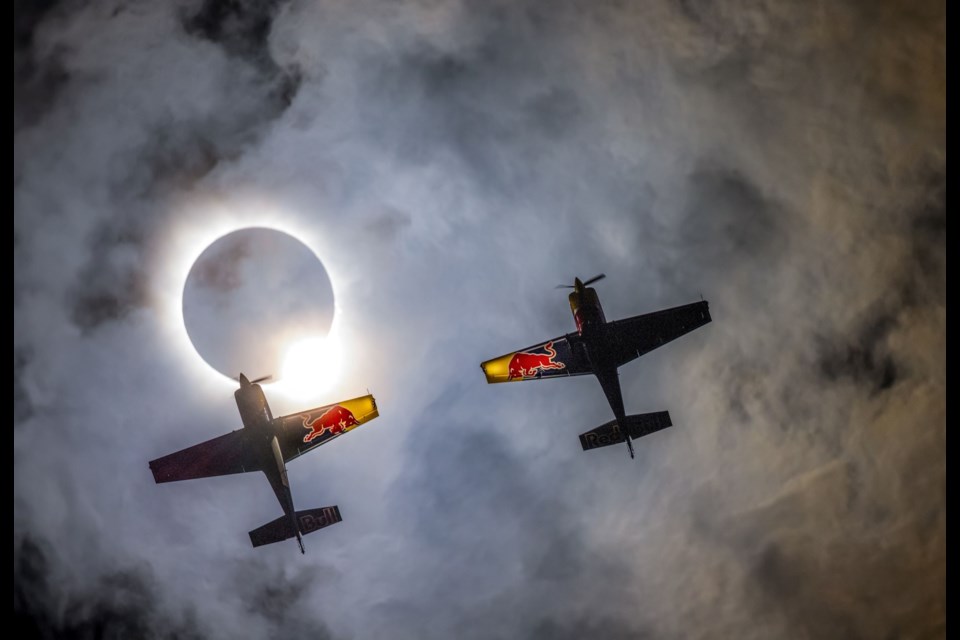On April 8, a total solar eclipse left millions across parts of Canada, Mexico and the United States in awe. Many flocked outside to witness the breathtaking occurrence, donning appropriate forms of protective eyewear, while some had the equipment and know-how to capture their own striking pictures.
Mason Mashon, Dustin Snipes and Peter McKinnon one-upped them all. The three seasoned photographers teamed up with Red Bull aerobatic pilots Pete McLeod and Kevin Coleman to choreograph a set of truly unrivaled images each worth far, far more than a thousand words.
For Mashon, a 2023 Red Bull Illume finalist who witnessed his first total eclipse in Oregon six years ago, the project was a highlight of his career.
"This is one of the hardest photos that I’ve ever tried to capture,” he comments in a press release. “There are known settings to capture an eclipse, but when you need to figure out the height of the planes above ground level to frame and scale them perfectly with the eclipse—during totality—it’s a totally different game.”
Painstaking preparation
Dateline: Sulphur Springs. The town of just over 16,000 people in Northeast Texas fell under the eclipse’s shadow at 1:40 p.m. local time, with totality (the period of time when the moon fully obscures the sun’s disk) lasting about four minutes.
A small window of opportunity, and one that can’t be replicated.
Mashon and his peers spent weeks upon weeks drawing up their game plan. Numerous rehearsals were conducted with the attention to detail of a Broadway show, while calculations dictating aircraft velocities and locations were made with military-esque precision.
Red Bull Air Force member Luke Aikins took instructions from the photographers and radioed them up to McLeod and Coleman like an air traffic controller. The pilots flew only four feet apart at an altitude of 1500 feet and an average speed of just under 290 kilometres/hour.
Moving as fast as possible without compromising a tight formation, they expected to make only three quick passes during totality. For a former race pilot like McLeod, this unique task brought with it a unique sense of adrenaline.
“When you get into a race track or a freestyle routine, a lot of it is very well-practiced and there’s not usually a ton of surprises,” explains the Ontario native. “But throughout the process of making [these images] happen, it was just a new challenge every day. As soon as you overcome one, you’re on to another.
“It wasn’t so much about nerves of competition—like how are you going to do relative to others—but rather: ‘what have you not considered?’”
Each day, McLeod and Coleman climbed into the cockpits of their Extra 300 series planes: highly maneuverable, piston-driven machines ideal for aerobatics. Both aircraft had reflective wrappings installed on their wings to make them more visible, especially when the skies got dark.
And they most certainly did.
From day to dusk
McLeod anticipated the eclipse to resemble twilight, with the sun’s lingering afterglow providing a measure of vestigial illumination. He and Coleman had trained extensively in such conditions.
Instead, they experienced something akin to an accelerated nightfall. City lights throughout Sulphur Springs turned on all at once, and the Red Bull team was transported from early afternoon to well beyond dusk in under a minute.
“It was surreal,” McLeod remembers. “I’d not witnessed or participated in totality before and I mentioned in flight that I was getting chills. Most of us, if not everyone, was genuinely surprised and shocked how dark it got. We underestimated that.”
Mashon, Snipes and McKinnon did their best, but weren’t fully satisfied with their stuff after three passes. That prompted Aikins to call an audible, directing McLeod and Coleman to shorten their circuit and attempt a fourth flyover.
“I’m not a photographer by any means … but I'm very aware that [Coleman and I] are spoiled to get to work with these guys,” says McLeod about the shooters on the ground. “If you can put it in front of them, they're going to make it happen, and that’s what’s cool about the teamwork here. There were multiple people with pivotal roles who were heavily relied on to have any sort of success in the outcome.”
As the planes soared overhead once more, a sliver of sunlight emerged. It was just enough for Mashon and the others to capture their best shots of the day.
“Pete and Kevin are some of the best fixed-wing pilots in the world,” says Mashon. “They know what to do and how to operate in high stress conditions. It's really impressive.”
The next total solar eclipse to be visible from any region of Canada or the contiguous United States is predicted to take place on August 23, 2044. Until then, the venture undertaken by Mashon, McLeod and company in Texas may stand alone as an example of what can happen when celestial bodies align with the right people.
“What we did in this project speaks to innovation, a spirit of adventure and thinking outside the box—doing something that integrates with the natural world around us, yet using all the fascinating tools and technology that humankind has come up with,” McLeod remarks. “It's not just an aviation photo. It's not just a photography photo. I think there's a lot of common ground there.”




